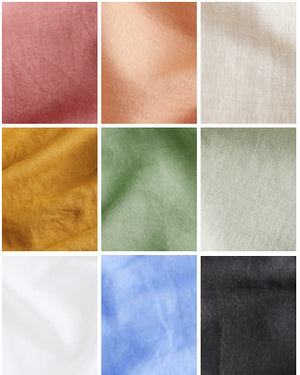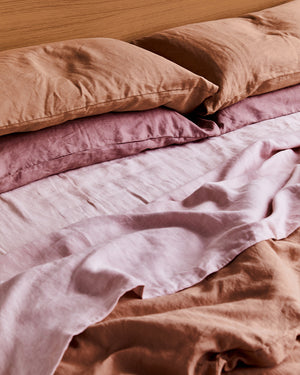What Is Flax Linen And How Is It Made?
Forgive us for stating the obvious, but we take our sleep extremely seriously. A candle should be burning by your bedside, your sheets should be soft yet stylish—yielding to an optimal 6-8 hours of peaceful slumber no matter the climate—and our heads should be resting on 100% pure French flax linen pillows in order to maximise the sweetest of dreams.
It’s a foolproof algorithm for a good night’s sleep, but what if we begged the question that’s prone to keeping you up all night? We know the one: what is flax linen and how is it made?
To quash any further restlessness and keep your wandering mind at bay, read on as we unpack the A-Z’s of flax linen so you can sleep easy tonight.
What Is Flax Linen And How Is It Made?
What exactly is flax linen?
Flax linen is a plant-derived material that originates from flax or linum usitatissimum. In technical terms, flax is actually considered a vegetable—so you can be sure that you are making the most of your sleep health when you purchase our Threads.
The cellulose fibre in the stem of the flax plant can be harvested and then spun to produce flax linen or to harvest flax oil. This cellulose fibre—commonly known as a bast fibre—is a fibre that is recovered from the inner bark of a plant, similar to how we extract hemp and rattan.
How long have we been harvesting flax?
Flax has been cultivated for over 5 millennia—it even stretches back to the pharaonic times of ancient Egypt. In ancient Greece and Rome, flax was also a popular trade commodity and is believed to have once been the most valuable textile in the whole world. Durable (approximately 30% thicker and stronger than cotton), hardwearing and comparatively easier on the environment than cotton or silk, flax has stood the test of time and is still one of the most luxurious kinds of linen available on the market.
What’s the fuss about flax?
The process of producing flax linen is time-consuming, weather dependent, and labour-intensive. Flax is not particularly challenging to grow, however, it thrives in cool environments with moist, damp soil, and struggles to survive in extreme heat.
Flax is also a fragile plant—the cellulose fibres that are trapped in the woody stalk have to be removed with extreme caution—meaning that in parts of the world, this extraction is still prepared by hand as has been customary for centuries.
Flax is cultivated in many parts of the world, but the best flax grows along the flax belt—a stretch of Europe that spans across Belgium, France and Holland—we source our flax from France, so you can rest assured it is 100% pure and 100% superior.
How is flax made?
Flax harvesting is a slow, time-consuming process—it takes roughly 100 days to produce flax linen from seed planting to harvesting. Flax needs to be shallowly planted, in damp soil and only grows in cool temperatures. Once it turns yellow or brown, the flax is ready to harvest.
At this stage, the woody bark that contains the cellulose fibres is chemically retted or decomposed using water in order to retrieve the useful part of the plant. The flax plant is then squeezed, dried, combed and spun—a process through which the stronger or longer flax fibres—called line or dressed flax—are separated from the weak—called 'stricks'.
This separation is integral: the dressed flax will produce more luxurious, hardwearing linen—the kind that ensures your Bed Threads will outlast their wearers and be passed down as future heirlooms. Finally, these dressed flax are spun and dyed with eco-friendly dyestuff to produce your bed linen—a costly process in time and labour that reaps the ultimate reward.
Our entire range is OEKO-TEX 100 certified (so, no nasty chemicals in your Threads).
The result?
Our 100% pure French flax linen insulates in the winter, cools in the summer and pleases all year round. The special care taken in preparing the cellulose fibres means that your linen is easy to wash, endures for years, and only improves its buttery softness with age, so you can flaunt your flax expertise and fall asleep within minutes of hitting the pillow.
Enjoyed this? This is why linen becomes softer over time.
Have more questions? Head over to our Linen FAQ page.



















